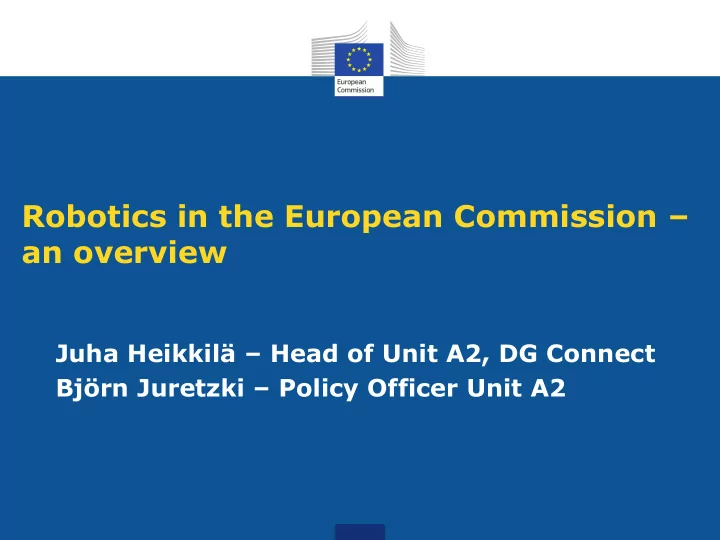

Robotics in the European Commission – an overview Juha Heikkilä – Head of Unit A2, DG Connect Björn Juretzki – Policy Officer Unit A2
Why are robots important? • In a globalised economy, Europe cannot compete on labour costs • To address societal challenges, e.g. health, environment and demographic change leading to a shrinking work force in Europe • The future of manufacturing is the whole manufacturing system working in concert (Industry 4.0) Intelligent robots are crucial for Europe's future competitiveness!
Support to European robotics so far • Almost 100 ongoing projects • over 700 partners • over € 500m funding in the Seventh Framework Programme for Research & Development • € 70m –€ 80m funding for new projects per year (about 20 new projects every year) • 1 call per year, up to 200 proposals • Covering all application domains from industrial robotics to healthcare to agriculture
Future support and Public-Private Partnership in Robotics (SPARC) • Purpose of PPP: developing a strategy and vision for the future of European robotics together with stakeholders • Investment: € 700 million public investment (biggest civilian robotics programme in the world) complemented by € 2.1bn private investment • Overall goal: increasing the market share of European robotics producers from currently 35% to 42% by 2020 • PPP up and running: first calls developed in collaboration with private side already implemented
Legal issues • We will only reach our ambitious goals, e.g. with respect to market shares, when we also address the non-technical issues • Legal issues high on the agenda, four main thrusts: • Data protection (robots equipped with sensors gather a lot of data, consent from workers on the shop floor) • Liability (what happens when an autonomous cars causes an accident) • Health and Safety (collaborative robots outside the cage) • Sector-specific rules (drones/integration in airspace, autonomous cars/Vienna Convention)
Robotics and the labour market • Effects on labour market hotly debated • Tentative evidence that robots create jobs and don't destroy them: • EC-commissioned Fraunhofer study: companies that use robots are less likely to offshore production to outside Europe • If the past is any indicator, no need for overblown worries: industrialization created millions of jobs • Example of app economy: did not exist 7 years ago, now annual revenues of around $100bn • Re-skilling of workforce needed • We should look with optimism to the future!
Societal aspects/EB survey • Societal concerns have to be taken seriously • Key results of recent Eurobarometer survey on autonomous systems: • 89% of respondents consider robotics a technology that requires careful management • 70% of respondents think robots steal people's jobs (unchanged compared to 2012 wave) • 64% of respondents have a positive view of robots (down from 70% in 2012) • 85% of respondents agree that robots can do jobs that are too hard/dangerous for people
Recommend
More recommend